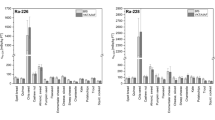Abstract
Neutron activation analysis, inductively coupled plasma emission spectrometry(ICP-ES) and atomic absorption spectroscopy (AAS) have been used to determineactual daily dietary intakes of minerals and trace elements in the Iranianpopulation. This article deals with the trace elemental analysis of dailydiets of the Iranian population differentiated with respect to food habits,geographical variability, literacy and income. Three study groups in fiveregions were defined. Thirty total daily diet samples were prepared basedon the method of dietary records. Also a few samples representing the intakesof two other study groups, males and females, were prepared by the duplicatediet method. Therefore, this study not only covered representative dietarypatterns of almost all adult people in Iran in a pilot study, but it alsopermitted to check the validity of the sampling methodology for total mixeddiet simulation.
Similar content being viewed by others
References
International Atomic Energy Agency, Elemental Analysis of Biological Materials, Technical Reports Series. No. 197, Vienna, 1980, p. 105.
Z. B. Alfassi, Determination of Trace Elements, Balaban Publishers, Cambridge, 1994, p. 145.
C. Vandecasteele, C. B. Block, Modern Methods for Trace Element Determination, John Wiley & Sons, New York, 1994, p. 168; 299.
G. W. Ewing, Instrumental Methods of Chemical Analysis, 5th ed., McGraw-Hill Book Company, New York, 1985, p. 109; 444.
V. Iyengar, Analytical Approaches, in: Clinical Nutrition by St. Louis, Vol. 6, No. 3, The C.V. Mosby Company, 1986, p. 105.
S. Hattangadi, Ind. Chem., 8 (1987) No. 2, 46.
J. J. M. de Goeij, Trans. Am. Nucl. Soc., 56 (1988) 194.
J. J. M. de Goeij, Trans. Am. Nucl. Soc., 60 (1989) 19.
V. Valcovic, Trace Element Analysis, Taylor & Francies Ltd., London, 1975, p. 35.
D. H. Buss, Chem. Ind., (1983) 496.
E. J. Uderwood, Trace Elements in Humane and Animal Nutrition, Vol. 1, Academic Press, New York, 1986, p. 1.
H. L. S. Tandon, Micronutrient in Soils, Crops and Fertilizers, New Delhi, 1995, p. 4.
R. M. Parr, H. Crawley, Dietary Intakes of Minor and Trace Elements: A Global Survey, IAEA, Vienna, 1989.
National Research Council Recommended Dietary Allowances, Vol. 10, National Academy Press, Washington DC, 1989, p. 195.
World Health Organization, Trace Elements in Human Nutrition and Health, Geneva, 1996, p. 47.
J. Kucera, I. Obrusnik, E. Sabbioni, Nuclear Analytical Method in the Science, Humana Press, New Jersey, 1994, p. 415; 481 and 651.
R. M. Parr, Dietary Intakes of Trace Elements and Related Nutrients in Eleven Countries, TEMA, Dubrovnik, 1990, p. 1.
L. A. Currie, R. M. Parr, Exploration of Inter and Intra Regional Multivariable Patterns in the IAEA, Global Daily Diet Data, Euro-Analysis VII, Vienna, 1990.
A. G. Gharib, Working Papers for IAEA-RCM on Trace Elements of the Population of Iran, Ankara, Turkey, 23–26 Oct., 1989.
A. G. Gharib, A Preliminary Report on Human Daily Dietary Intakes of Nutritionally Important Trace Elements as Measured by Nuclear and other Techniques from Iran, IAEA, 1992.
R. M. Parr, Research Protocol IAEA, 1984.
G. V. Iyengar, Protocol for Sample Collection and Handling Procedure, Joint FDA-IAEA-NBS-USDA, 1985.
R. M. Parr, Newsletter IAEA, No. 4 (1998).
A. G. Gharib, K. Fatemi, M. Madali, H. Rafiee, Darabizadeh, to be published.
A. Aminpour, Preparation of Total Daily Diets of Iranian Communities (Persian), Int. Reports, Institute of Food and Nutrition, Tehran, 1988, p. 1.
A. G. Gharib, A. AMINAPOUR, J. Sci. Food Technol., 1 (1991) 42.
J. A. T. Rennington, J. Am. Dietetic Assoc., 82 (1983) No. 2, 166.
Institute of Nutrition and Food Industry of Iran, The National Study of Food Consumption, Raw Material Report, No. 761, Tehran, 1999.
M. T. Horisian, L. D. UNGER, Trace Elements, in: Nutrition for Hospitalized Patient, Marcel Dekker, Inc., 1995, p. 167.
A. G. Gharib, Int. Report, AEOI, Tehran-Iran, 2000, p. 1.
Author information
Authors and Affiliations
Rights and permissions
About this article
Cite this article
Ahmadiniar, A. Simulation of Iranian total mixed diets and their analysis for essential and toxic trace elements using nuclear and complementary analytical techniques. Journal of Radioanalytical and Nuclear Chemistry 249, 47–60 (2001). https://doi.org/10.1023/A:1013228111540
Issue Date:
DOI: https://doi.org/10.1023/A:1013228111540




